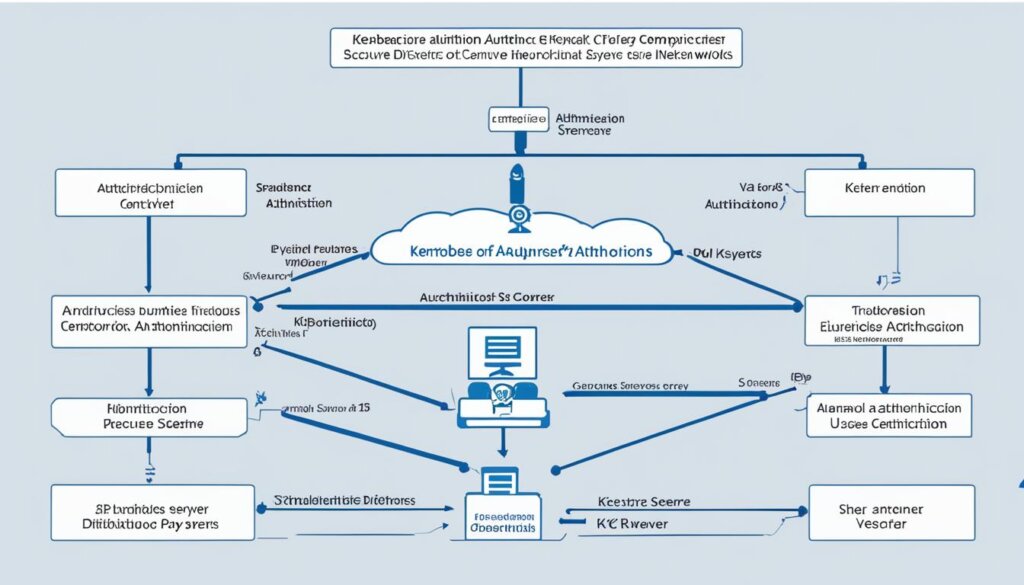Table of Contents
Welcome to our comprehensive guide on Kerberos, the network authentication protocol that ensures secure communication between trusted hosts across untrusted networks. In this guide, we will explore the ins and outs of Kerberos, its key features, and its various applications in the realm of network security.
Kerberos, initially developed by MIT for Project Athena in the 1980s, has gained widespread adoption in operating systems such as Windows, Apple OS, FreeBSD, UNIX, and Linux. This security protocol utilizes secret-key cryptography and a trusted third party known as the Key Distribution Center (KDC) to verify user identities and provide robust security measures.
The primary purposes of Kerberos include single sign-on authentication, network authentication, mutual authentication, and authorization. It enables users to authenticate once and obtain a ticket that grants access to various resources without the need for repeated credential input.
Throughout this guide, we will delve deeper into the inner workings of Kerberos, its role in securing computer networks, its authentication protocol, the benefits it brings to cybersecurity setups, and its relationship with other technologies such as LDAP. So let’s dive in and explore the world of Kerberos in detail!
What is Kerberos?
Kerberos is a computer network security protocol that plays a crucial role in ensuring the authenticity and security of service requests within a computer network. It enables secure communication between trusted hosts across an untrusted network, such as the internet. Developed by MIT for Project Athena in the late 1980s, Kerberos has become a default authorization technology in popular operating systems like Microsoft Windows.
At its core, Kerberos relies on secret-key cryptography and utilizes a Key Distribution Center (KDC) to verify user identities and protect against eavesdropping and replay attacks. By employing robust security measures, Kerberos prevents unauthorized entities from intercepting or tampering with service requests, ensuring the integrity and confidentiality of the network.
By authenticating service requests, Kerberos establishes a trusted environment that allows users to securely access resources and services within the network. This enhances overall network security and mitigates the risks associated with operating in an untrusted network architecture.
With the prevalence of cyber threats and the importance of secure communication, Kerberos remains a critical component of modern computer network security. Its ability to authenticate users, protect against attacks, and facilitate secure service requests makes it a valuable tool in safeguarding network environments.
| Benefits of Kerberos: |
|---|
| 1. Enhanced network security |
| 2. Authentication and verification of user identities |
| 3. Protection against eavesdropping and replay attacks |
| 4. Reliable access to network resources |
Example Use Case:
Alice, an employee in a corporate network, needs to access a secured file server. Through the Kerberos authentication protocol, she can securely request access to the file server. The Key Distribution Center verifies Alice’s identity and grants her a ticket, allowing her to establish a secure session with the file server without repeatedly entering her credentials. This streamlined authentication process reduces the risk of password-based attacks and ensures efficient access control.
How Does Kerberos Work?
Kerberos, a widely used security protocol, operates on the principles of secret-key cryptography and relies on a trusted third party known as the Key Distribution Center (KDC) to authenticate and verify user identities. Understanding how Kerberos works provides insights into its robust security mechanisms and the seamless authentication process it offers.
- When a client requests access to a service, the KDC plays a critical role in the authentication process. It authenticates the client’s request and issues a Ticket Granting Ticket (TGT), which serves as proof of the client’s identity.
- The KDC also provides the client with a session key, allowing for secure communication between the client and the authorized services.
- Using the TGT, the client can then request service tickets for specific resources from the KDC.
- These service tickets are used by the client to authenticate its identity to the requested service and establish a secure session.
In essence, Kerberos relies on secret-key cryptography to ensure secure communication between the client and the services it seeks to access. By employing a trusted third party and issuing TGTs and service tickets, Kerberos offers a streamlined and highly reliable authentication process.
“Kerberos provides secure and efficient user authentication while minimizing the risk of unauthorized access to resources.” – Expert in network security
| Advantages of Kerberos Authentication | Benefits |
|---|---|
| Robust Security | Kerberos utilizes secret-key cryptography to ensure secure communication and protect against unauthorized access. |
| Single Sign-On (SSO) | Users authenticate once and obtain a ticket that can be used to access multiple resources without repeatedly providing credentials. |
| Efficient Access Control | Kerberos provides effective access control by centralizing logins and security policy enforcement. |
| Mutual Authentication | Both the client and the server authenticate each other during the initial authentication process, providing enhanced security. |
What is Kerberos Used For?
Kerberos is a critical component in secure systems that require robust auditing and authentication capabilities. It plays a crucial role in various applications and technologies, enhancing the overall security and access control of these systems.
Some of the key applications and use cases of Kerberos include:
- Posix Authentication: Kerberos is widely used for authenticating users in Posix-based systems, such as UNIX and Linux.
- Active Directory: In Microsoft Windows environments, Kerberos is the default authentication protocol used for domain accounts in Active Directory, ensuring secure authentication and access control.
- NFS (Network File System): Kerberos provides secure authentication and access control for NFS, enabling users to access shared files and resources safely.
- Samba: Kerberos is used with Samba, an open-source software suite that facilitates interoperability between Windows and UNIX-like systems, ensuring secure access to shared files and printers.
Kerberos also serves as an alternative authentication system for various network protocols, including SSH (Secure Shell), POP (Post Office Protocol), and SMTP (Simple Mail Transfer Protocol), strengthening the security of these protocols.
Additionally, the main uses of Kerberos encompass:
- Single Sign-on (SSO): Kerberos enables users to authenticate once and obtain a ticket that can be used to request service tickets for various resources without repeatedly providing credentials. This streamlined login process enhances user convenience and efficiency.
- Network Authentication: Kerberos ensures secure authentication of users in a networked environment, verifying their identities and granting access to authorized resources.
- Mutual Authentication: Kerberos facilitates mutual authentication between the client and the server, establishing a trust relationship that ensures both parties are verified and authorized before accessing sensitive resources.
- Authorization: By effectively managing user identities and access control policies, Kerberos acts as a robust authorization mechanism, safeguarding sensitive data and resources from unauthorized access.
“Kerberos is a versatile security protocol widely used in secure systems, providing reliable auditing and authentication capabilities. It ensures secure access to various resources and enhances overall system security.”
Example Use Case: Kerberos in Active Directory

| Use Case | Description |
|---|---|
| Domain Authentication | Secure authentication and access control for domain user accounts in Active Directory. |
| Single Sign-on (SSO) | Enables users to authenticate once and access multiple resources without needing to re-enter credentials. |
| Group Policy Enforcement | Facilitates effective and centralized management of security policies and access control across the domain. |
| Secure File and Print Services | Ensures secure access to shared files, printers, and other resources within the domain. |
Kerberos Authentication Protocol
The Kerberos authentication protocol, initially developed by MIT for Project Athena, plays a crucial role in ensuring secure network communication. It comprises three key components: the client, the network resource (application server), and the Key Distribution Center (KDC). These components work together to facilitate trusted host authentication over untrusted networks, guaranteeing that only authorized users can access valuable network resources.
With the Kerberos protocol, authentication, authorization, and accounting (AAA) security can be effectively enforced. It grants tickets that allow hosts to prove their identity and securely access resources. By employing secret-key cryptography and the concept of trusted third-party authentication, the Kerberos protocol offers robust security measures to safeguard sensitive information and prevent unauthorized access.
To illustrate the role of each component:
- The client: This component initiates the authentication process by sending a ticket request to the Key Distribution Center (KDC). The client must validate its identity credentials, typically a username and password, to proceed further.
- The network resource: Also known as the application server, this component responds to the client’s request to access a specific resource or service. It relies on the KDC to authenticate the client’s identity and ensure it has the necessary permissions to access the requested resource.
- The Key Distribution Center (KDC): The KDC acts as a trusted third party in the authentication process. It verifies the client’s identity, issues a ticket known as a Ticket Granting Ticket (TGT), and provides a session key for secure communication between the client and the network resource. The KDC stores the necessary authentication information, encrypted using secret keys, to ensure authentication and integrity throughout the process.
By securely authenticating each party involved, the Kerberos authentication protocol establishes a foundation of trust in network interactions, preventing unauthorized intruders from compromising sensitive data or resources. It enables organizations to implement strong access control mechanisms, ensuring that only authorized users can access valuable network assets.
Benefits of Kerberos Authentication
Kerberos authentication brings several benefits to cybersecurity setups. It provides effective access control by giving users a single point to manage logins and security policy enforcement. With Kerberos, administrators can easily grant and revoke access privileges for users, ensuring that only authorized individuals can access sensitive resources.
Another advantage of Kerberos authentication is the limited lifetime for key tickets. Each ticket issued by the Kerberos server has a specified expiration time. This means that even if an attacker manages to obtain a ticket, they will have a limited time window to exploit it. Regular ticket expiration enhances security by minimizing the risk of unauthorized access.
Kerberos also provides mutual authentication between the client and the server. During the initial authentication process, both parties verify each other’s authenticity, preventing man-in-the-middle attacks and unauthorized access attempts. This two-way authentication ensures that only trusted clients and servers can establish a secure connection.
Furthermore, Kerberos authentication employs strong and diverse security measures to protect sensitive information. It utilizes robust cryptography and encryption algorithms to secure the communication between the client and the server. By using industry-standard security protocols, Kerberos ensures that data transmitted over the network remains confidential and cannot be easily intercepted or manipulated.
Kerberos vs LDAP
Kerberos and LDAP are commonly used in conjunction to facilitate centralized user management and secure authentication in larger networks. While LDAP acts as a centralized user directory, storing information about users, groups, and other objects in one central location, Kerberos offers secure authentication through a centralized authentication service.
Unlike LDAP, which requires the transmission of user passwords over the network, Kerberos enables single sign-on functionality, eliminating the need for users to remember and manage multiple passwords. With Kerberos, users can authenticate once and obtain a ticket that can be used to request access to various network resources without the need to repeatedly provide credentials.
By combining Kerberos and LDAP, organizations can enjoy substantial security benefits. The centralized user directory of LDAP ensures consistent management of user information, while Kerberos’ secure authentication service provides an additional layer of protection. Together, they enhance the security of larger networks and streamline the user authentication process.
FAQ
What is Kerberos?
Kerberos is a computer network security protocol that authenticates service requests between two or more trusted hosts across an untrusted network, such as the internet. Developed by MIT for Project Athena in the late 1980s, it is now a default authorization technology in Microsoft Windows and other operating systems. Kerberos uses secret-key cryptography and the Key Distribution Center (KDC) to verify user identities and protect against eavesdropping and replay attacks.
How Does Kerberos Work?
Kerberos works by employing secret-key cryptography and a trusted third party called the Key Distribution Center (KDC). When a client requests access to a service, the KDC authenticates the client’s request, issues a ticket known as a TGT (Ticket Granting Ticket), and provides a session key for secure communication. The client uses the TGT to request service tickets for specific resources, and the service tickets are used to authenticate and establish a secure session with the requested service.
What is Kerberos Used For?
Kerberos is used heavily in secure systems that require reliable auditing and authentication features. It is employed in Posix authentication, Active Directory, NFS, Samba, and as an alternative authentication system to SSH, POP, and SMTP. The main uses of Kerberos include single sign-on (SSO), network authentication, mutual authentication, and authorization. It enables users to authenticate once and obtain a ticket that can be used to request service tickets for various resources without repeatedly providing credentials.
What is the Kerberos Authentication Protocol?
The Kerberos authentication protocol was developed by MIT for Project Athena. It consists of three main components: the client, the network resource (application server), and the Key Distribution Center (KDC). These components enable trusted host authentication over untrusted networks, ensuring that only authorized users can access network resources. The Kerberos protocol provides authentication, authorization, and accounting (AAA) security, and it grants tickets that allow hosts to prove their identity and access resources.
What are the Benefits of Kerberos Authentication?
Kerberos authentication brings several benefits to cybersecurity setups. It provides effective access control by giving users a single point to manage logins and security policy enforcement. It also allows for limited lifetime for key tickets, ensuring that each ticket has a specified expiration time. Mutual authentication is achieved, meaning both the client and the server authenticate each other during the initial authentication process. Kerberos authentication also employs strong and diverse security measures, such as cryptography and encryption, to ensure secure communication and protect against unauthorized access.
What is the Difference Between Kerberos and LDAP?
Kerberos and LDAP are often used together to provide centralized user management and secure authentication. While LDAP stores information about users, groups, and other objects in a central location, Kerberos provides secure authentication through a centralized authentication service. LDAP requires the transmission of user passwords over the network, while Kerberos enables single sign-on functionality, eliminating the need for multiple passwords. The combination of Kerberos and LDAP offers substantial security benefits in larger networks.













